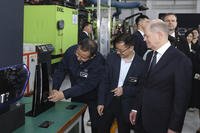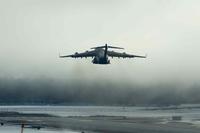
Whats more effective in the fight in Iraq and Afghanistan: air power or boots on the ground.
Well if you ask the Air Force Chief of staff, hell tell you its his aircraft providing the greatest combat punch.
[Air Force] Secretary [Michael] Wynne asked the staff last week to look at which component has had the biggest effect on attrition of hostiles. Staff came back and said it looks like the air component is killing bad guys at a higher rate than anyone else I have anecdotal evidence from the staff that says airpower is the most lethal of the components in wrapping up bad guys.
As far as numbers of people killed, as far as wrapping up bad guys and as far as delivering a kinetic effect the air component which also includes Marine and Navy air, by the way is the most lethal of the components. I have not seen those numbers but I thought that was a useful observation
I considered that position which Moseley revealed during an April 24 interview - this morning when I saw the latest air power summery from Southwest Asia on the Air Force Web site:
4/25/2007 - SOUTHWEST ASIA (AFNEWS) -- Coalition airpower supported coalition ground forces in Iraq and International Security Assistance Force troops in Afghanistan in the following operations April 24, according to Combined Air and Space Operations Center officials here.
In Afghanistan, an Air Force B-1B Lancer provided overwatch for a coalition convoy near Qarah Bagh. No attacks were reported after the B-1B's arrival.
U.S. Navy F/A-18 Super Hornets provided a show of force for a coalition forces position near Saraw. A joint terminal attack controller confirmed it was successful and no further attacks were reported. The aircrews also provided overwatch for a coalition patrol in the same area.
French M-2000 Mirages provided a show of force for a coalition forces position near Asadabad. No attacks were reported after the M-2000s arrived.
In total, 41 close-air-support missions were flown in support of ISAF and Afghan security forces, reconstruction activities and route patrols.
Nine Air Force intelligence, surveillance and reconnaissance aircraft flew missions in support of operations in Afghanistan. Additionally, four U.S. Navy and Royal Air Force aircraft performed tactical reconnaissance.
In Iraq, Air Force F-16 Fighting Falcons searched for mortar positions and improvised explosive device activity near Baghdad. The pilots were then assigned to look for anti-Iraqi militia hiding nearby. They reported the coordinates of three hot spots.
Other F-16s performed armed overwatch for coalition forces who received small-arms fire near Salman Pak. The pilots reported three individuals hiding along a fence near a mosque.
Air Force A-10 Thunderbolt IIs provided a show of force, releasing multiple flares, for a raid near Baqubah by coalition forces. A JTAC reported the show of force was successful. The pilots also provided reconnaissance in the area and reported suspicious activity to a JTAC.
F/A-18s provided a show of force, releasing multiple flares, for coalition forces receiving small-arms fire near Yusufiyah. A JTAC confirmed it was successful and no further attacks were reported.
RAF GR-4 Tornados provided overwatch to look for snipers for a explosive ordnance disposal team near Yusufiyah. The aircrews then were assigned to look for a truck involved in an engagement with coalition forces. The aircrew found a truck matching the description of the truck in the attack, at a building nearby. Individuals were reported to be unloading objects from the truck.
Other GR-4s provided shows of force for coalition forces near a crowd of approximately 250 people near Baghdad. A JTAC confirmed it dispersed the crowd and no attacks were reported.
In total, coalition aircraft flew 55 close-air-support missions for Operation Iraqi Freedom. These missions supported coalition ground forces, protected key infrastructure, watched over reconstruction activities and helped to deter and disrupt terrorist activities.
Fifteen Air Force, Navy and Royal Australian Air Force ISR aircraft flew missions in support of operations in Iraq. Additionally, three Air Force and RAF fighter aircraft performed tactical reconnaissance.
Air Force C-130 Hercules aircraft and C-17 Globemaster IIIs provided intra-theater heavy airlift support, helping to sustain operations throughout Afghanistan, Iraq and the Horn of Africa. More than 125 airlift sorties were flown; nearly 410 tons of cargo were delivered, and approximately 2,200 passengers were transported.
Coalition C-130 crews from Australia, Canada, Iraq, Japan and South Korea flew in support of OIF or OEF.
On April 22, Air Force, French and RAF tankers flew 50 sorties and off-loaded more than 3 million pounds of fuel.
Now, I dont see any bomb dropping in there. But Im willing to bet soldiers and Marines have been mixing it up in both Iraq and Afghanistan today, with more lethal effects than popping a few flares to disperse a crowd.
I wonder what the ground-pounders will say about Moseleys and the USAF secretarys - conviction that airpower is killing more bad guys than Joes and Leathernecks.
-- Christian







